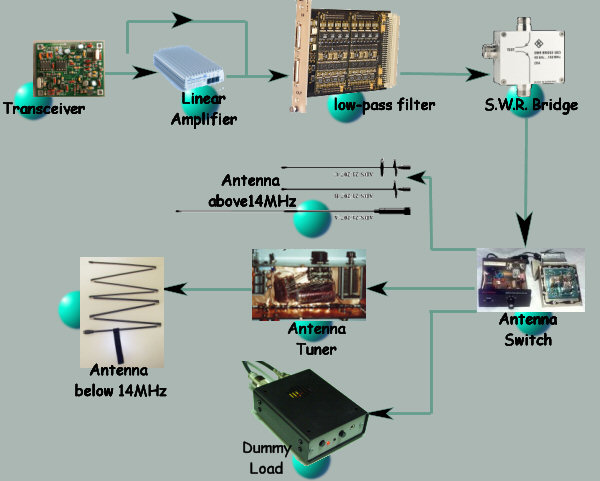Amateur Radio Service is Governed by 3 pieces of legislation:
Notes from ![]()
| Radio Communication Act | http://laws.justice.gc.ca/en/R-2/index.html |
| Regulations | http://laws.justice.gc.ca/en/showtdm/cr/SOR-96-484 |
| International Telecommunications Union | http://www.itu.int/home/index.html |
* Industry Canada RIC – 2 and RIC 3
Radio Communications Act contains:
1. Requirements to obtain license 2. Penalites for failure to do so
The Act states that you cannot:
install, operate or possess a device capable of transmitting electromagnetic waves lower than 3000GHz without being licenced in accordance with the Act. Also, the equipment must be located in a place with a station license.
The Regulations encompasses:
the rules for the hobby including 3rd party traffic, bandwidth, permitted frequencies, communications content, power limits, etc.
- post yellow/white station license
- 3rd party traffic means a message sent to a non-amateur via an amateur station.
- there are some countries which it is forbidden to communicate with (N. Korea, Iran)
- Obscene Language
- Confidentiality
- You must state your CALLSIGN at the beginning and end of an exchange. You must identify again at 30mins. Identification must be in English or French.
- You may only communicate with other amateur stations
- You cannot develop a secret code
- You cannot play music or commercially recorded material
- You cannot demand nor accept remuneration for any communication
Sanctions under the Act
- maximum fine of $5000.00
- imprisonment for up to 1 year
- or both
Regulations Continued …
Bandwidth:
is the portion of the band that your transmitted signal occupies:
| Signals below 25MHz | shall not exceed 6 kHz bandwidth (except 10.1 10.15 MHz –> 1 kHz ) |
| 28.0 – 29.7 MHz | shall not exceed 20 kHz bandwidth |
| 50 MHz – 144 MHz | shall not exceed 30 kHz bandwidth |
| 200 MHz | shall not exceed 100 kHz bandwidth |
| 430 MHz | 12 MHz (Amateur Television) |
Transmitter Power:
- direct current input power: Basic License – max 250 watts Advanced License – max 1 kW : to the anode or collector or circuit of the transmitter stage
- radio frequency output power measured across an impedance matched load: Basic License – max 560 watts peak envelope power. Advanced License – max 2250 watts (for transmitters producing SSB emission) or Basic License – max 190 watts carrier power. Advanced License – max 750 watts (for other types of emission)
Harmful Interference:
- interference must neither endanger or degrade the use or functioning of safety-related transmitters and receivers (ie police, ambulance, coast guard)
- or, significantly degrade, obstruct or repeatedly interrupt the use or functioning of radio apparatus or radio sensitive equipment.
Measurements:
- Device capable of measuring the transmitted frequency (with the same accuracy as a crystal calibrator), AND
- Device capable of preventing and indicating overmodulation, AND
- Frequency stability of the transmitter of frequencies below 148 MHz must be equivalent to a crystal-controlled radio.
** All modern transceivers meet these 3 requirements.
Number of Amateur Radio Stations
You may have:
2 Type 1 site-specific stations
1 module station
** Only 2 stations can operate simultaneously (one of which must be the mobile station)
** Station does not mean transmitter, so, station may have many transmitters operating simultaneously
Emergency Communications
Amateur stations have the authority to communicate any message that relates to an emergency (earthquake, flood, tornado) on behalf of any person, government, or relief organization.
Distress: – grave and imminent danger, need immediate assistance: “MAYDAY, MAYDAY, MAYDAY, CALLSIGN” Repeat until you get a response. Priority over all other communication.
Urgency:- urgent message concerning safety of person, place, vehicle, plane or vessel. “PAN PAN, PAN PAN, PAN PAN, CALLSIGN”. Priority over all other communication except distress.
Safety: – safety navigation or weather advisories. “SECURITY, SECURITY, SECURITY CALLSIGN”
Safety Code 6
Health Canada’s document “Limits of Exposure to Radiofrequency Fields at Frequencies from 10kHz to 300 GHz”
http://www.hc-sc.gc.ca/ewh-semt/pubs/radiation/99ehd-dhm237/preface-preambule_e.html
Certification
Basic Certificate (70%)
- restricted to frequencies above 30MHz
- lower power below 250W
- not be the license holder of a repeater
- not be holder of a club station
- must use commercially manufactured equipment
Advance Certification (80%+)
- operate on HF bands
- below 30 MHz
- operate less than 1000W
The frequency allocations for Canada in ITU Region 2 are:
|
Frequency (MHz) Lower edge |
Frequency (MHz) Upper edge |
Maximum Bandwidth |
Qualifications |
|
1.8 |
2.0 |
6 kHz |
B and 5 |
|
3.5 |
4.0 |
6 kHz |
B and 5 |
|
7.0 |
7.3 |
6 kHz |
B and 5 |
|
10.1 |
10.15 |
1 kHz |
B and 5 |
|
14.0 |
14.350 |
6 kHz |
B and 5 |
|
18.068 |
18.168 |
6 kHz |
B and 5 |
|
21.0 |
21.450 |
6 kHz |
B and 5 |
|
24.890 |
24.990 |
6 kHz |
B and 5 |
|
28.0 |
29.7 |
20 kHz |
B and 5 |
|
50.0 |
54.0 |
30 kHz |
B |
|
144 |
148 |
30 kHz |
B |
|
220 |
225 |
100 kHz |
B |
|
430 |
450 |
12 MHz |
B ** |
|
902 |
928 |
12 MHz |
B ** |
|
1,240 |
1300 |
Not Specified |
B ** |
|
2,300 |
2,450 |
Not Specified |
B ** |
|
3,300 |
3,500 |
Not Specified |
B ** |
|
5,650 |
5,925 |
Not Specified |
B ** |
|
10,000 |
10,500 |
Not Specified |
B ** |
|
24,000 |
24,050 |
Not Specified |
B |
|
24,050 |
24,250 |
Not Specified |
B ** |
|
47,000 |
47,200 |
Not Specified |
B |
|
75,500 |
76,000 |
Not Specified |
B |
|
76,000 |
81,000 |
Not Specified |
B ** |
|
142,000 |
144,000 |
Not Specified |
B |
|
144,000 |
149,000 |
Not Specified |
B ** |
|
241,000 |
248,000 |
Not Specified |
B ** |
|
248,000 |
250,000 |
Not Specified |
B |
Notes:
“B” means an Amateur Operators Certificate with Basic Qualification
“5” means an Amateur Operators Certificate with Morse Code (5 w.p.m.) Qualification
Radio Amateurs are secondary users in the bands marked with asterisks **, and may not cause interference to primary users.
CANADIAN CALLSIGN PREFIXES
| VE1, VA1 | NS |
| VE2, VA2 | QC |
| VE3. VA3 | ON |
| VE4, VA4 | MB |
| VE5, VA5 | SK |
| VE6, VA6 | AB |
| VE7, VA7 | BC |
| VE8 | NWT |
| VE9 | NB |
| VE0 | International Waters |
| VO1 | NF |
| VO2 | Labrador |
| VY1 | Yukon |
| VY2 | PEI |
| VY0 | Nunavut |
Phonetic Alphabet
| alpha | beta | charlie | delta | echo |
| foxtrot | golf | hotel | india | julliet |
| kilo | lima | mike | november | oscar |
| papa | quebec | romeo | sierra | tango |
| uniform | victor | whiskey | xray | yankee |
| zulu |
Q Code
See More: http://www.kloth.net/radio/qcodes.php
| Q Code | Ques | Ans | Remember |
|---|---|---|---|
| QRZ | Who is calling me? | You are being called by … | Snooze |
| QSO | Can you communicate with… direct .. or relay? | I can communicate with… direct .. or relay | So and So |
| QRM | Are you being interfered with? | I am being interfered with … 1,2,3,4,5 | Radio Man |
| QRN | Are you troubled by static? | I am troubled by static … 1,2,3,4,5 | Radio Natural |
| QRS | Shall I send more slowly? | Send more slowly (wpm) | Radio Slower |
| QTH | What is your position? | My position is lat long | The Home |
| QSL | Can you acknowledge receipt? | I can acknowledge receipt. | QSL Card |
| QRG | Can your tell me my exact frequency? | Your exact frequency is KHz or MHz | RiG frequency |
| QRT | Shall I stop sending? | Stop Sending. | Radio Terminate |
| QTR | What is the exact time? | Exact Time is … 2000 Z | Time Right Now |
| QRO | Shall I increase my transmitter power? | Increase your transmitter power. | Ridiculously Overload |
| QRP | Shall I decrease my transmitter power? | Decrease transmitter power. | Reduce Power |
| QSY | Shall I change frequency? | Change frequency to … | See You Change |
| QRH | Does my frequency vary? | Change frequency to … | Radio Hold Frequency |
| QRI | How is the tone of my frequency? | The tone of your transmission is 1=good, 2= variable, 3=bad | Radio Intonate |
| QRK | What is the intelligibility of my signal (or those of …)? | The intelligibility of your signal is 1=bad, 2=poor, 3=fair, 4=good, 5=excellent | Radio Klearly |
1 nil
2 slightly
3 moderately
4 severely
5 extremely

The DC input power of a transmitter operating at 12 volts and drawing 500 milliamps would be: 6 watts
P = E × I = 12 × .5 = 6 watts
Current and Voltage
Current (I) is the flow of electrons through a conductor, and is measured in amperes (A).
Voltage (E) is the electrical pressure, or electromotive force, that causes the electrons to flow, and is measured in volts (V).
 The ampere is named for André Marie Ampère, a mathematician and physicist who made major contributions to the theory of electromagnetism.
The ampere is named for André Marie Ampère, a mathematician and physicist who made major contributions to the theory of electromagnetism. The volt is named for Alessandro Giuseppe Antonio Anastasio Volta, a pioneer in the study of electricity and inventor of the electric battery.
The volt is named for Alessandro Giuseppe Antonio Anastasio Volta, a pioneer in the study of electricity and inventor of the electric battery.
|
Resistance
Resistance (R) is the opposition to current, and is measured in ohms (Ω). A resistor is a circuit component that provides resistance. Resistors are made from materials with moderate resistance, like carbon. Bad Beer Rots Our Young Guts But Vodka Goes Well. The Standard EIA Color Code Table per EIA-RS-279 is as follows:
Note: red to violet are the colors of the rainbow where red is low energy and violet is higher energy. |
 |
|||||||||||||||||||||||||||||||||||||||||||||||||||||||||||||||||||||||||||||||||||||||||||||||||||||||||||||||
|
||||||||||||||||||||||||||||||||||||||||||||||||||||||||||||||||||||||||||||||||||||||||||||||||||||||||||||||||
Series versus Parallel Circuits


A series circuit is wired so that current passes through a series of components, one after the other.
In a parallel circuit, current branches out through multiple paths. Kirchhoff’s Current Law says that the sum of the currents flowing into any branching point is equal to the sum of the currents flowing out. In other words:
IA = IB + IC
 |
German physicist Gustav Robert Kirchhoff (1824-1887) made major contributions to our understanding of electricity, spectroscopy, and other fields. |
Ohm’s Law
|
Ohm’s Law shows the relationship between:
This law is expressed by three equivalent formulas:
|
A rule of “thumb” for remembering Ohm’s Law Move the mouse over a letter to see its formula  |
An ohm is defined as the resistance of a circuit in which a 1 ampere current flows when 1 volt is applied.
 German physicist, Georg Simon Ohm (1787-1854), who formulated Ohm’s Law.
German physicist, Georg Simon Ohm (1787-1854), who formulated Ohm’s Law.
Resources
Amateur Certification – Fact Sheet – Industry Canada
RIC-2 – Standards for the Operation of Radio Stations in the Amateur Radio Service




